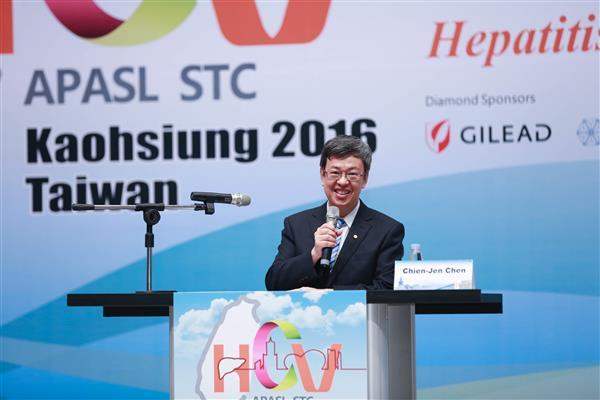News & activities
 News releases
News releases
2016-06-11
Vice President Chen's opening speech at 2016 APASL Single Topic Conference on Hepatitis C
On the afternoon of June 11, Vice President Chen Chien-jen attended the 2016 APASL (Asian Pacific Association for the Study of the Liver) Single Topic Conference on Hepatitis C in Taiwan's southern city of Kaohsiung. In his opening speech, the vice president welcomed the experts and scholars from both home and abroad on behalf of the government of Taiwan to participate in the event, and expressed hope that the global healthcare community can work together to eradicate the hepatitis C virus successfully in the near future.
A transcript of Vice President Chen's remarks follows:
President Masao Omata of APASL, President Chien Rong-nan (簡榮南) of Taiwan Association for the Study of the Liver (TASL), President Lin Jaw-town (林肇堂) of the Gastroenterological Society of Taiwan (GEST), Chairperson of today's conference Dr. Chuang Wan-long (莊萬隆), dear colleagues, ladies and gentlemen:
There are a lot of old friends and new friends here. It is really my pleasure and honor to extend a heartfelt greeting to all of you on behalf of the Taiwan government.
I am truly pleased to have this opportunity to join you here in Kaohsiung for the 2016 APASL Single Topic Conference on Hepatitis C.
Addressing the theme of "Hepatitis C: Before and Beyond Cure", it is especially apt that the TASL and the GEST have been conferred the honor and responsibility of organizing this prestigious international meeting.
Taiwan has a proud history at the forefront of global initiatives to reduce the burden of viral hepatitis. We have very outstanding scholars here, such as Professors Chen Ding-shinn (陳定信), Liao Yun-fan (廖運範), and Kao Jia-horng (高嘉宏). They have really contributed a lot to the control of hepatitis here in Taiwan. The world's first universal hepatitis B immunization program began in July 1984 right here in Taiwan, and it became a model for the World Health Organization global immunization program, which has made great strides to reduce the burden of HBV infection worldwide.
However, the hepatitis C virus (HCV) was discovered in 1989, and it became evident that this virus also imposed substantial burdens of diseases, especially in our region, the Asia-Pacific region.
Fortunately, just as mentioned by Chairperson Chuang and President Omata, progress over the past 25 years has been astonishingly rapid, and has made it possible to virtually cure HCV. Again, pioneering Asian researchers contributed major breakthroughs here. A glance through the meeting program shows that many of them are here with us. So it is really my pleasure to meet my old friends and new friends here. You did contribute a lot to the control of hepatitis C in this region as well as in the whole world. And I would like to take this opportunity to join you to thank all the outstanding investigators here.
However, to eradicate HCV globally will be an enormous undertaking. There would be no need to hold a conference were it otherwise. There are still major challenges to address and knowledge gaps to fill – from basic research and prevention to diagnosis and treatment.
This conference provides a forum to discuss the latest developments on all aspects of HCV. But more importantly, it will serve to reinvigorate existing collaborations and to foster new ones – for it is only by working together that the global healthcare community can eradicate HCV successfully in near future.
Once again I would like to thank the organizers for their excellent work on this vital conference. As mentioned by Professor Omata, there are more than 1,500 participants here, and I believe that all of you will enjoy a very successful and fruitful conference. So finally, I would like to wish you a most memorable and inspiring meeting. Thank you very much.
A transcript of Vice President Chen's remarks follows:
President Masao Omata of APASL, President Chien Rong-nan (簡榮南) of Taiwan Association for the Study of the Liver (TASL), President Lin Jaw-town (林肇堂) of the Gastroenterological Society of Taiwan (GEST), Chairperson of today's conference Dr. Chuang Wan-long (莊萬隆), dear colleagues, ladies and gentlemen:
There are a lot of old friends and new friends here. It is really my pleasure and honor to extend a heartfelt greeting to all of you on behalf of the Taiwan government.
I am truly pleased to have this opportunity to join you here in Kaohsiung for the 2016 APASL Single Topic Conference on Hepatitis C.
Addressing the theme of "Hepatitis C: Before and Beyond Cure", it is especially apt that the TASL and the GEST have been conferred the honor and responsibility of organizing this prestigious international meeting.
Taiwan has a proud history at the forefront of global initiatives to reduce the burden of viral hepatitis. We have very outstanding scholars here, such as Professors Chen Ding-shinn (陳定信), Liao Yun-fan (廖運範), and Kao Jia-horng (高嘉宏). They have really contributed a lot to the control of hepatitis here in Taiwan. The world's first universal hepatitis B immunization program began in July 1984 right here in Taiwan, and it became a model for the World Health Organization global immunization program, which has made great strides to reduce the burden of HBV infection worldwide.
However, the hepatitis C virus (HCV) was discovered in 1989, and it became evident that this virus also imposed substantial burdens of diseases, especially in our region, the Asia-Pacific region.
Fortunately, just as mentioned by Chairperson Chuang and President Omata, progress over the past 25 years has been astonishingly rapid, and has made it possible to virtually cure HCV. Again, pioneering Asian researchers contributed major breakthroughs here. A glance through the meeting program shows that many of them are here with us. So it is really my pleasure to meet my old friends and new friends here. You did contribute a lot to the control of hepatitis C in this region as well as in the whole world. And I would like to take this opportunity to join you to thank all the outstanding investigators here.
However, to eradicate HCV globally will be an enormous undertaking. There would be no need to hold a conference were it otherwise. There are still major challenges to address and knowledge gaps to fill – from basic research and prevention to diagnosis and treatment.
This conference provides a forum to discuss the latest developments on all aspects of HCV. But more importantly, it will serve to reinvigorate existing collaborations and to foster new ones – for it is only by working together that the global healthcare community can eradicate HCV successfully in near future.
Once again I would like to thank the organizers for their excellent work on this vital conference. As mentioned by Professor Omata, there are more than 1,500 participants here, and I believe that all of you will enjoy a very successful and fruitful conference. So finally, I would like to wish you a most memorable and inspiring meeting. Thank you very much.
Related News
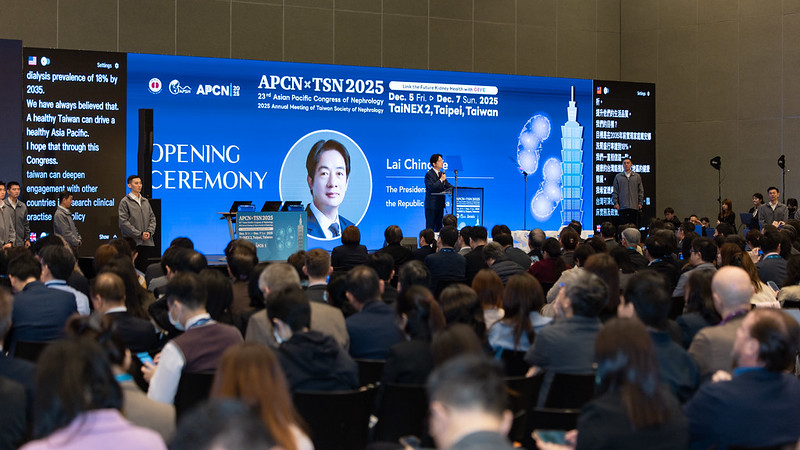
2025-12-05
President Lai attends opening of 23rd Asian Pacific Congress of Nephrology
On the morning of December 5, President Lai Ching-te attended the opening of the 23rd Asian Pacific Congress of Nephrology held in conjuncti...
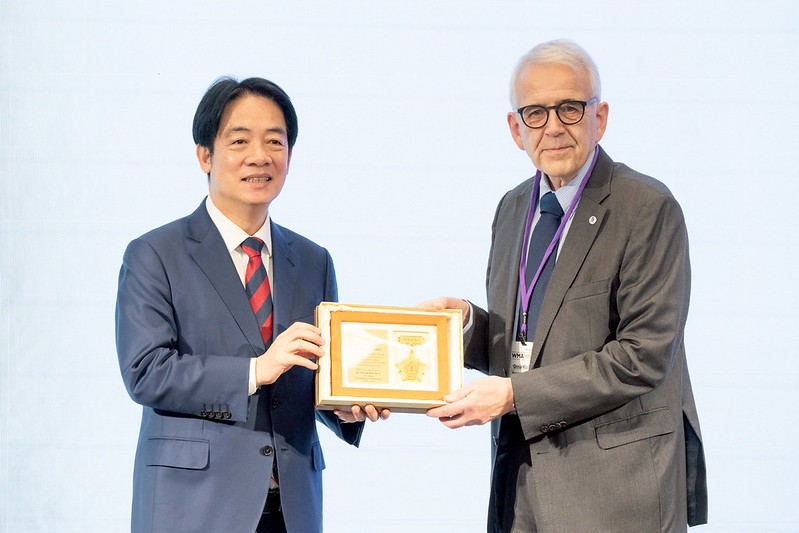
2025-12-04
President Lai attends opening of Taiwan Medical Association’s International Symposium on Transforming Healthcare
On the morning of December 4, President Lai Ching-te attended the opening of the Taiwan Medical Association (TMA)’s International Symp...
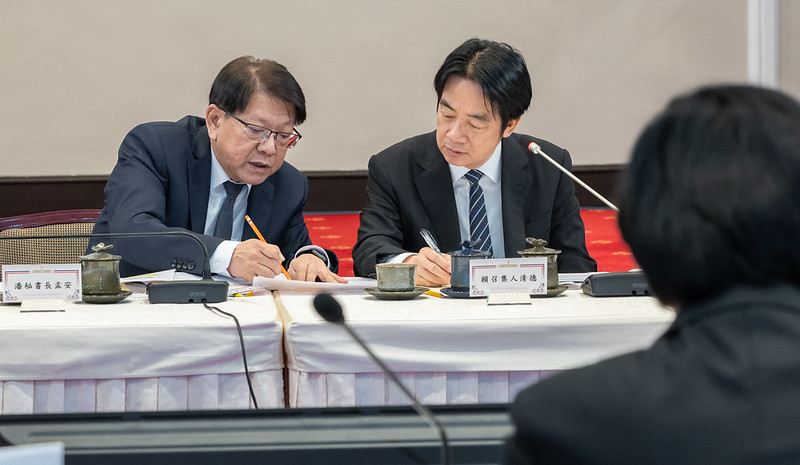
2025-09-04
President Lai presides over fifth meeting of Healthy Taiwan Promotion Committee
On the afternoon of September 4, President Lai Ching-te presided over the fifth meeting of the Healthy Taiwan Promotion Committee. In his op...
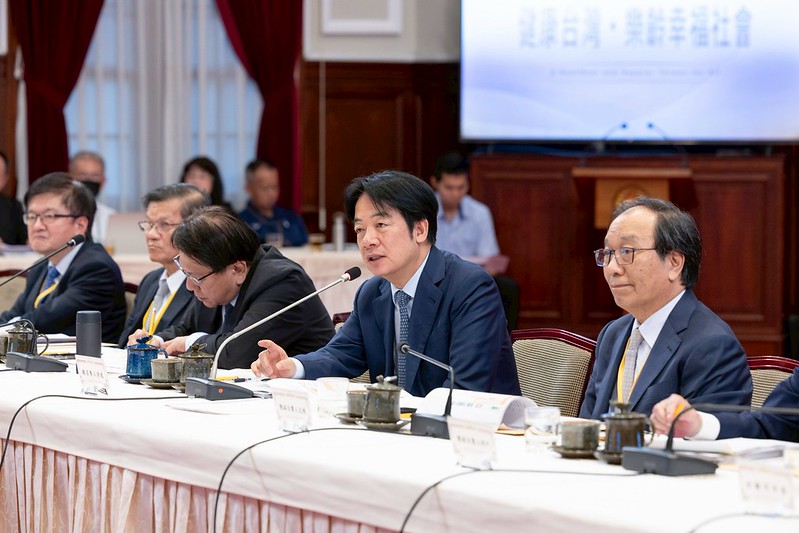
2025-05-22
President Lai presides over fourth meeting of Healthy Taiwan Promotion Committee
On the afternoon of May 22, President Lai Ching-te presided over the fourth meeting of the Healthy Taiwan Promotion Committee. In his openin...
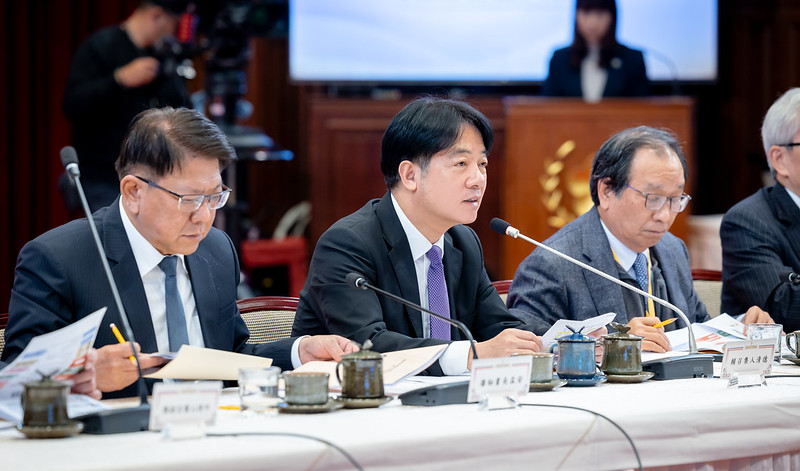
2025-02-27
President Lai presides over third meeting of Healthy Taiwan Promotion Committee
On the afternoon of February 27, President Lai Ching-te presided over the third meeting of the Healthy Taiwan Promotion Committee. In his op...



